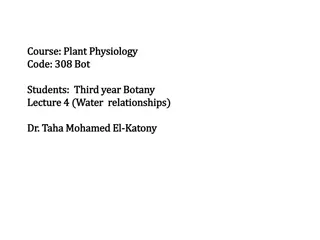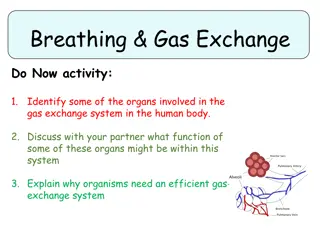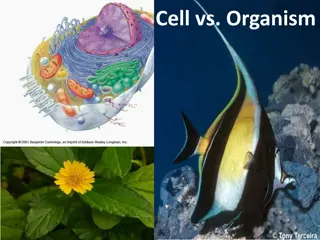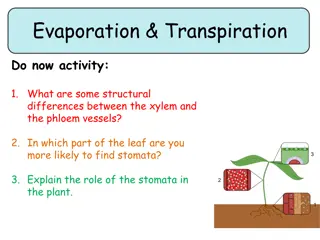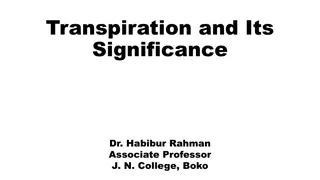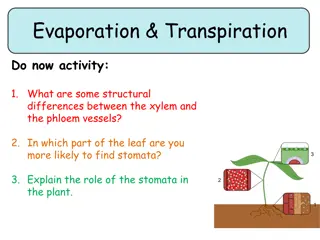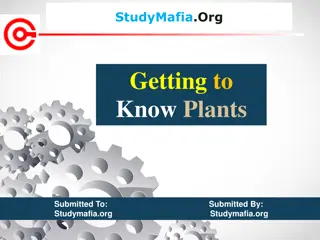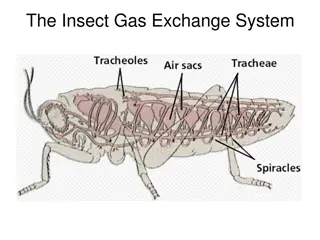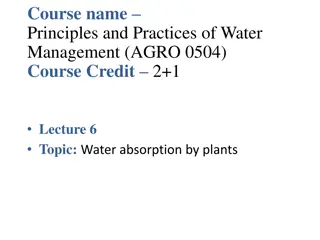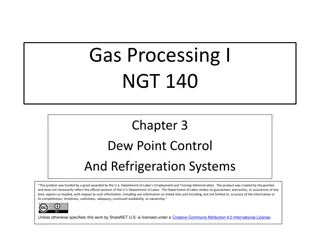Understanding Transpiration and Gas Exchange in Plants
Transpiration is the evaporation of water from plants, mainly occurring through the leaves' stomata. Plants exchange gases like CO2 and O2 through various parts, without specialized organs. The process aids in photosynthesis, respiration, and cooling, demonstrating the importance of transpiration in plant life. Environmental factors, such as light, also influence the rate of transpiration in plants.
Download Presentation

Please find below an Image/Link to download the presentation.
The content on the website is provided AS IS for your information and personal use only. It may not be sold, licensed, or shared on other websites without obtaining consent from the author. Download presentation by click this link. If you encounter any issues during the download, it is possible that the publisher has removed the file from their server.
E N D
Presentation Transcript
What is Transpiration? Transpiration is the evaporation of water from plants. It occurs chiefly at the leaves while their stomata areopen for the passage of CO2 and O2during photosynthesis.
Gas Exchange in Plants In order to carry onphotosynthesis, green plants need a supply of carbon dioxide and a means of disposing of oxygen. In order to carry on cellular respiration, plant cells need oxygen and a means of disposing of carbon dioxide (just as animal cells do).
Unlike animals, plants have no specialized organs for gas exchange (with the fewinevitable exceptions!). The are several reasons they can get along withoutthem: Each part of the plant takes care of its owngas exchange needs. Roots, stems, and leaves respire at ratesmuch lower than are characteristic ofanimals.
The only living cells in the stem are organizedin thin layers just beneath the bark. The cells in the interior are dead and serve only to provide mechanical support. Oxygen and carbon dioxide also pass throughthe cell wall and plasma membrane of the cell by diffusion. The diffusion of carbon dioxide may be aided by aquaporin channels inserted in the plasma membrane.
Leaves The exchange of oxygen and carbon dioxidein the leaf (as well as the loss of water vapor in transpiration) occurs through pores called stomata (singular = stoma). Normally stomata open when the lightstrikes the leaf in the morning and close duringthe night.
RATE OFTRANSPIRATION Osmotic Pressure, lb/in2 Time 7 A.M. 212 11 A.M. 456 5 P.M. 272 12 midnight 191
Importance Transpiration is not simply a hazard of plantlife. It is the "engine" that pulls water up from the roots to: supply photosynthesis (1%-2% of thetotal) bring minerals from the rootsfor biosynthesis within theleaf cool the leaf
Environmental factors that affect the rate of transpiration 1. Light Plants transpire more rapidly in the light than in the dark. This is largely becauselight stimulates the opening of the stomata (mechanism). Light also speeds up transpiration by warming theleaf.
2. Temperature Plants transpire more rapidly at higher temperatures because water evaporates more rapidly as the temperature rises. At 30 C, a leaf may transpire three times as fastas it does at 20 C.
3. Humidity The rate of diffusion of any substance increases as the difference in concentration of the substances inthe two regions increases.When the surrounding air is dry, diffusion of water out of the leaf goes on more rapidly.
4. Wind When there is no breeze, the air surrounding a leaf becomes increasingly humid thus reducing the rate of transpiration. When a breeze is present, the humid air is carried away andreplaced by drier air.
5. Soil water A plant cannot continue to transpire rapidly if its water loss is not made upby replacement from the soil. This immediately reduces the rate of transpiration (as well as of photosynthesis). The volume of water lost intranspiration can be veryhigh.
Adaptation How it works Example thick cuticle most dicots stops uncontrolled evaporation through leaf cells small leaf surface area less area for evaporation conifer needles, cactus spines fewer gaps in leaves low stomata density most dicots stomata on lower surface of leaf only more humid air on lower surface, so less evaporation deciduous plants shedding leaves in dry/cold season reduce water loss at certain times of year
sunken stomata marram grass, pine maintains humid air around stomata stomatal hairs maintains humid air around stomata marram grass, couch grass folded leaves marram grass, maintains humid air around stomata stores water cacti succulent leaves and stem extensive roots maximise water uptake cacti
Project prepared by Jenefa Joanna





